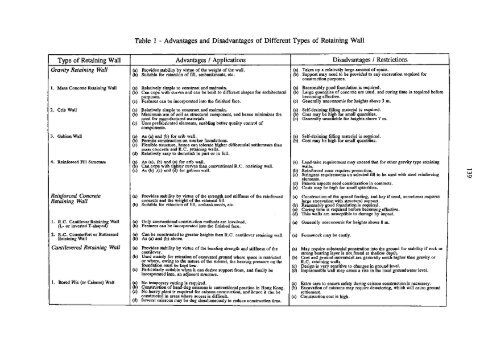GEOGUIDE 1 GUIDE TO RETAINING WALL ... - HKU Libraries
GEOGUIDE 1 GUIDE TO RETAINING WALL ... - HKU Libraries
GEOGUIDE 1 GUIDE TO RETAINING WALL ... - HKU Libraries
- No tags were found...
Create successful ePaper yourself
Turn your PDF publications into a flip-book with our unique Google optimized e-Paper software.
Table 1 - Advantages and Disadvantages of Different Types of Retaining WallType of Retaining Wall Advantages / Applications Disadvantages / RestrictionsGravity Retaining Wall1, Mass Concrete Retaining Wall2. Crib Wall3, Gabion Wall4. Reinforced Fill StructureReinforced ConcreteRetaining Wall1. R.C. Cantilever Retaining Wall(L- or inverted T-shaped)2. R.C. Counterfort or ButtressedRetaining WallCantilevered Retaining Wall1. Bored Pile (or Caisson) Wall(a) Provides stability by virtue of the weight of the wall.(b) Suitable for retention of fill, embankments, etc.(a) Relatively simple to construct and maintain.(b) Can cope with curves and can be built to different shapes for architecturalpurposes.(c) Features can be incorporated into the finished face.(a) Relatively simple to construct and maintain.(b) Maximum use of soil as structural component, and hence minimizes theneed for manufactured materials.(c) Uses prefabricated elements, enabling better quality control ofcomponents.(a) As (a) and (b) for crib wall.(b) Permits construction on weaker foundations.(c) Flexible structure, hence can tolerate higher differential settlements thanmass concrete and R.C. retaining walls.(d) Relatively easy to demolish in part or in full.(a) As (a), (b) and (c) for crib wall,(b) Can cope with tighter curves than conventional R.C. retaining wall,(c) As (b) ,(c) and (d) for gabion wall.(a) Provides stability by virtue of the strength and stiffness of the reinforcedconcrete and the weight of the retained fill.(b) Suitable for retention of fill, embankments, etc.(a) Only conventional construction methods are involved.(b) Features can be incorporated into the finished face.(a) Can be constructed to greater heights than R.C. cantilever retaining wall.(b) As (a) and (b) above.(a) Provides stability by virtue of the bending strength and stiffness of thecantilever.(b) Used mainly for retention of excavated ground where space is restrictedor where, owing to the nature of the subsoil, the bearing pressure on thefoundation must be kept low.(c) Particularly suitable when it can derive support from, and finally beincorporated into, an adjacent structure.(a) No temporary cutting is required,(b) Construction of hand-dug caissons is conventional practice in Hong Kong.(c) No heavy plant is required for caisson construction, and hence it can beconstructed in areas where access is difficult.(d) Several caissons may be dug simultaneously to reduce construction time.(a) Takes up a relatively large amount of space.(b) Support may need to be provided to any excavation required forconstruction purposes.(a) Reasonably good foundation is required.(b) Large quantities of concrete are used, and curing time is required beforebecoming effective,(c) Generally uneconomic for heights above 3 m.(a) Self-draining filling material is required.(b) Cost may be high for small quantities.(c) Generally unsuitable for heights above 7 m.(a) Self-draining filling material is required.(b) Cost may be high tor small quantities.(a) Land-take requirement may exceed that for other gravity type retainingwalls.(b) Reinforced zone requires protection.(c) Stringent requirements on selected fill to be used with steel reinforcing(d)(e)elements.Patents aspects need consideration in contracts.Costs may be high for small quantities.(a) Construction of the spread footing, and key if used, sometimes requireslarge excavation with structural support.Reasonably good foundation is required.Curing time is required before becoming effective.(d) Thin walls are susceptible to damage by impact.(a) Generally uneconomic for heights above 8 m.(a) Formwork may be costly.(a) May require substantial penetration into the ground for stability if rock orstrong bearing layer is not found at shallow depth.(b) Cost and ground movement are generally much higher than gravity orR.C. retaining walls.(c) Design is very sensitive to changes in ground level.(d) Impermeable wall may cause a rise in the local groundwater level.(a) Extra care to ensure safety during caisson construction is necessary.(b) Excavation of caissons may require dewatering, which will cause groundsettlement.(c) Construction cost is high.vo
















